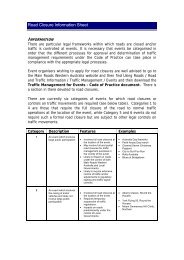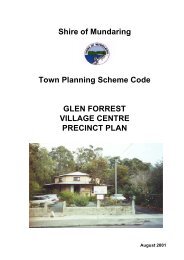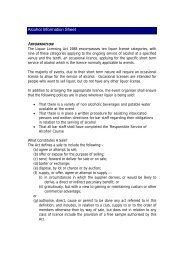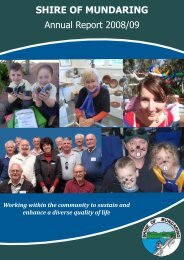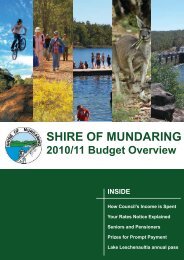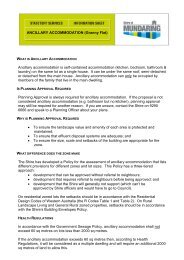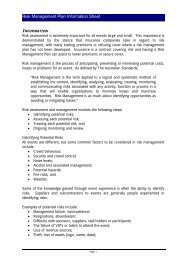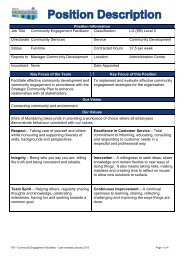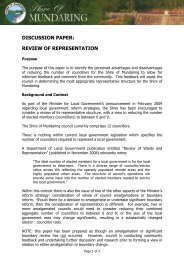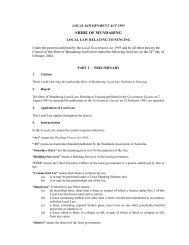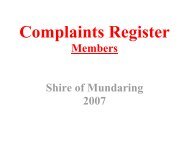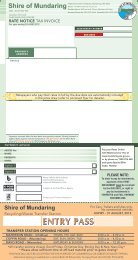SoM Keeping of Stock Brochure Final - Shire of Mundaring
SoM Keeping of Stock Brochure Final - Shire of Mundaring
SoM Keeping of Stock Brochure Final - Shire of Mundaring
Create successful ePaper yourself
Turn your PDF publications into a flip-book with our unique Google optimized e-Paper software.
The Approval Process<br />
When lodging your planning application, ensure you<br />
have completed the following tasks:<br />
• Complete Form 1 Application for Planning<br />
Approval<br />
•<br />
Identify any environmental features that need to<br />
be protected from stock and explain how they will<br />
be protected<br />
• Complete the Management Plan Pr<strong>of</strong>orma<br />
• Prepare a scale site plan <strong>of</strong> the property to<br />
accompany the Management Plan<br />
• Pay the relevant Planning Application Fee<br />
Once your application has been lodged it will be<br />
assigned to a Planning Officer and you will be<br />
notified <strong>of</strong> the decision.<br />
Compliance with your<br />
management plan<br />
The <strong>Shire</strong>’s Town Planning Scheme is a statutory<br />
document; therefore any activity outside your<br />
planning approval would be considered an <strong>of</strong>fence.<br />
<strong>Shire</strong> staff may conduct follow-up inspections<br />
<strong>of</strong> your property to ensure your approved<br />
management plan is being followed.<br />
Environmental Problems<br />
Caused by <strong>Stock</strong><br />
If livestock is kept in an unsustainable manner, the<br />
following environmental problems can occur:<br />
• Grazing and trampling can loosen soil causing<br />
wind and water erosion<br />
•<br />
Creeks or wetlands that are not fenced give<br />
livestock uncontrolled access leading to bank<br />
erosion and a decrease in water quality,<br />
vegetation and habitat<br />
• Nutrient run<strong>of</strong>f from fertilizers and manure into<br />
adjacent watercourses can cause algal blooms<br />
downstream<br />
• Eroded soils can generate dust, reducing air quality<br />
• Native vegetation can be damaged or lost leading<br />
to increased erosion<br />
• Manure that is not properly contained can cause<br />
odour and attract flies<br />
<strong>Keeping</strong> <strong>of</strong> <strong>Stock</strong><br />
<strong>Shire</strong> <strong>of</strong> <strong>Mundaring</strong><br />
The <strong>Keeping</strong> <strong>of</strong> <strong>Stock</strong> Guidelines<br />
All this information and more is contained within<br />
<strong>Shire</strong> <strong>of</strong> <strong>Mundaring</strong>’s Guidelines for <strong>Keeping</strong> <strong>Stock</strong>,<br />
available from the <strong>Shire</strong>’s Administration Building<br />
or online at www.mundaring.wa.gov.au under the<br />
Planning Information section.<br />
This information is available in different<br />
formats upon request. Please contact the<br />
<strong>Shire</strong> on 9290 6666.
<strong>Keeping</strong> <strong>of</strong> <strong>Stock</strong><br />
<strong>Keeping</strong> livestock can be a fun and rewarding<br />
occupation or past time, but it has the potential to<br />
cause environmental degradation if not carefully<br />
managed. The <strong>Shire</strong> <strong>of</strong> <strong>Mundaring</strong> encourages the<br />
sustainable keeping <strong>of</strong> livestock in a manner that<br />
preserves the rural lifestyle <strong>of</strong> the area.<br />
What is considered livestock?<br />
Under <strong>Shire</strong> <strong>of</strong> <strong>Mundaring</strong>’s Guidelines for <strong>Keeping</strong><br />
<strong>Stock</strong>, livestock includes but is not limited to a horse,<br />
cow, sheep, goat, deer, mule, alpaca, camel, donkey<br />
and any other member <strong>of</strong> such animal families.<br />
Where can stock be kept?<br />
There are a number <strong>of</strong> factors that determine if a<br />
property can suitably keep livestock. These include:<br />
• the zoning <strong>of</strong> the property<br />
• its size<br />
• the soil type present<br />
•<br />
proximity to any watercourses and native<br />
vegetation<br />
How much stock can I keep?<br />
The number <strong>of</strong> stock you can keep on your property,<br />
or <strong>Stock</strong>ing Rate, varies depending on whether you<br />
irrigate or not, the type <strong>of</strong> stock you intend to keep<br />
and the type <strong>of</strong> soil present on your property. The<br />
<strong>Stock</strong>ing Rate is calculated using a formula, which is<br />
available in the <strong>Keeping</strong> <strong>of</strong> <strong>Stock</strong> Guidelines.<br />
Why is my soil type important?<br />
Different properties in the <strong>Shire</strong> display different soil<br />
types. Some soil types are better suited than others<br />
for keeping livestock depending on characteristics<br />
such as drainage and susceptibility to erosion.<br />
<strong>Shire</strong> staff can assist you to identify the soil type<br />
present on your property.<br />
Can I clear native vegetation<br />
to keep livestock?<br />
No. The keeping <strong>of</strong> livestock is not a valid reason for<br />
clearing vegetation. <strong>Keeping</strong> livestock should not be<br />
done on blocks with significant vegetation.<br />
Do I need planning approval to<br />
keep livestock?<br />
Under the <strong>Shire</strong>’s Town Planning Scheme, planning<br />
approval is required to keep livestock in the <strong>Shire</strong>.<br />
This may be obtained by submitting a planning<br />
application accompanied by a management plan.<br />
Appendix 4 <strong>of</strong> the <strong>Shire</strong>’s Guidelines for <strong>Keeping</strong><br />
<strong>Stock</strong> contains an example framework that can assist<br />
you in preparing your management plan.<br />
Essential elements <strong>of</strong> a<br />
Management Plan to be<br />
included in your Application<br />
• Scale site plan <strong>of</strong> property<br />
• Statement <strong>of</strong> stock type and numbers<br />
• Measures for fly and odour control<br />
• Stabling practices<br />
• Collection and/or disposal <strong>of</strong> manure<br />
• Measures proposed for water management<br />
• Erosion control<br />
• Dust control<br />
• Existing vegetation protection and retention<br />
• Location <strong>of</strong> shelters/stables<br />
• Weed control<br />
• Type and condition <strong>of</strong> pasture<br />
• Fertiliser application rates<br />
•<br />
Fencing, including existing and future yard areas<br />
and environmentally sensitive areas (trees and<br />
watercourses)<br />
• Watercourses and areas prone to waterlogging<br />
•<br />
• Setbacks to neighbouring properties<br />
Revegetation <strong>of</strong> environmentally sensitive areas




